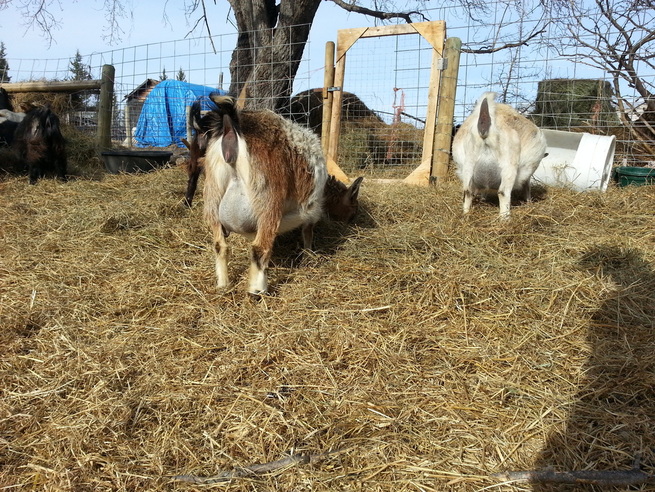 Sherry on the left and her mother Daphne on the right, are both very pregnant and ready to give birth. They are Nigerian Dwarf dairy goats and have huge udders for such little goats. Beautiful girls!
Sherry on the left and her mother Daphne on the right, are both very pregnant and ready to give birth. They are Nigerian Dwarf dairy goats and have huge udders for such little goats. Beautiful girls!
 Sherry on the left and her mother Daphne on the right, are both very pregnant and ready to give birth. They are Nigerian Dwarf dairy goats and have huge udders for such little goats. Beautiful girls! Sherry on the left and her mother Daphne on the right, are both very pregnant and ready to give birth. They are Nigerian Dwarf dairy goats and have huge udders for such little goats. Beautiful girls! The girls may be diminutive in size, but they almost rival a full sized goat for their udders. Daphne and Sherry are pure bred Nigerian Dwarf goats and Cecelia is about 7/8ths Nigerian. Cecelia had quads last year and kept three, but the little girl was the tiny one and got pushed away all the time. She would not take a bottle either and got weaker and weaker and succumbed one day after about a week. Daphne has had triplets and twins in the past. This is her third pregnancy and she is very large and so is her udder. Her daughter, who was bred to a Nigerian buck, is also ready to birth, likely a day before her mother by the look of her and her udder is huge and engorged. I have not tried to milk any goats, but the long teats would make the process quite a bit easier than say a Pygmy goat, though the Pygmy has richer milk with a higher percentage of butterfat. This year, I may try a milk share so I can make some goat's milk soap for the farm store. It is just a waiting game now, with any of the three ready to give birth at any moment. Beautiful little ladies, they are!
0 Comments
 Llamas are hard to tell if they are even pregnant. They do not develop an udder, only a low belly in the latter stages, which Lucy definitely has. Llamas are hard to tell if they are even pregnant. They do not develop an udder, only a low belly in the latter stages, which Lucy definitely has. The buck and the rams were put in with the girls on the first of December, making the first due date April 30th. As with humans it is always a little of give or take each way, and the ram cannot get to each girl the first day, although I am sure he tried. The young ewes, or hoggets, were in with a Babydoll Southdown ram until the Blue Faced Leicester trio joined them. Although the Blue Faced Leicester was with the ewe lambs he arrived with, it does not appear that they are bred, or if they are , they would have caught on the last heat making them due in mid June. But the ladies are ready. The llamas were transferred over to the sheep pen and the ewe lambs are with them now too to make lambing easier. There is a lambing shack and another area that is private, plus their shelter, but often the ewes just choose a quiet corner and lamb out in the open. The ravens hang around the pen and it is likely they were what cause the loss of four lambs last year who simply disappeared. So, I must be diligent and watchful. Sharon goat looks like she will have quads. Lucy Llama is definitely due, though Karin is not showing signs of being bred, which is a good thing, because I already have one too many llamas. I think Helga, the other Icelandic ewe will be the next sheep to give birth, but it really is waiting game as nature will take its course. One thing for sure, is that cuteness overload is about to happen!  The first babies arrived today around 10 am. Red, an Icelandic ewe, bred to an Icelandic ram, gave us two beautiful little girls, a solid black one and a coloured one just like herself, only a little lighter. Red is a fantastic mother. I saw that she was looking for a spot yesterday and the babies had dropped to the birth position. She was ready, but waited until this morning. It was a balmy 7 degrees and in no time, she had the little ewes cleaned off and up nursing. I brought Red some water and delicious alfalfa hay. She did have a few mouthfuls and some sips of water, but currently is more concerned with tending to her babies. The livestock guardian dog, Joe, has stayed near the birthing shack all day. He poked his nose in the doorway and Red quickly sent him out. I know the instinct of the dogs to protect is powerful, but they also have been known to kill lambs when they are playing. I will try to keep a close eye on the dogs, as this is their first experience with lambing and they are only nine months old themselves. Thank you Creator for the gift of life and thank you Red, for your beautiful baby girls!  The newly shorn sheep.The black and white ones are the Jacobs. The newly shorn sheep.The black and white ones are the Jacobs. The Fat Ewe Farm started out to be a fibre farm, hoping to have a little of many rare breeds with special wool and fleece. Over the past three years, many breeds have been tried and some have been kept, while others were immediately sold. The Shetland sheep are small and slow growing, but are also quite wild. I wanted a friendlier sheep. I tried East Friesien milk sheep, but they have been interfered with too much by man, always striving for more milk, with less regard for other traits, such as easy of lambing, foraging ability, parasite resistance. So they were all sold. The Barbados and Painted Desert sheep were interesting, but the Barbados is also small and wild and the Painted Desert did not have nice fleece, actually had hair and shed it. They too had to go. Currently there are Cotswolds, Blue Faced Leicesters, Icelandics, Karakuls, Jacobs, E'st a Laine Merino, Suffolk, Dorset and crosses of these breeds. The Cotswold ram is a very nice ram with an easy going personality, but it seems impossible to put any weight on him. Only one ewe of the three ewes kept her weight and has lovely fleece as strictly being grass fed . The ram and the other ewes and their lambs were heavily grain fed and did not develop the genes to revert to being grass fed, so they will go too. The Icelandics must be coated if their fleece is to be free of vegetative matter and I do not want to go through the expense and trouble to catch them five or six times to change the size of coats. The lambs are also slow growing and are hard to sell, especially the ram lambs. Everyone wants meaty chunky lambs. So I bought a Dorset and yes, her lamb is meaty and chunky for sure, but she was never handled and has kept her lamb away from human contact. They will have to go too. A Karakul ram was never found and one of the Karakul ewes strangled herself this winter. I love the sheep, but with one barren, she will have to be culled too. And the list will go on until there are only the Southdown Babydolls, Blue Face Leicesters and the Jacobs left. I do love the fleece of the Merino and Merino crosses and the one Cotswold ewe so will have to make a decision on those. Do I need to have so many sheepies? The last 12 bales of hay cost me one hundred dollars a bale delivered. Another aspect of the Babydolls and Jacobs is that they are small and eat so much less. With hay through the roof and hard to find, that is a huge factor in the decision making. And so, it is decided. Now will it happen? It is not easy to cull, sell or get rid of my sheep. Hmmm.  The first run of hatching eggs were candled yesterday. There are about 130 eggs in total, some duck, goose, chicken and turkey. The fertility rate is about 90%, which is very good for this early hatch, since the eggs were collected from outside when the temperatures were still very cold. Any frozen eggs, cracked eggs or eggs picked off the snow were discarded. The eggs were set and not washed. All eggs have a coating on them, the bloom, which protects the egg contents from bacteria and excess water, but allows air circulation and moisture to penetrate. Washing may remove the bloom or some of it, rendering the egg more vulnerable to problems and dehydration. The early candling only is an indicator that the eggs are fertile. Other problems could arise in time, hence the saying, "Don't count your chickens before they hatch!" There is a second set of eggs, duck, turkey, goose, guinea and chicken, that will follow the first by about 9 days. The waterfowl will go to one granary brooder and the chicks, turkey poults and guineas will go to the other. Waterfowl love water even from newly hatched eggs, but are subject to drowning, even in shallow water. They simply tire and stop swimming or dip their heads and sleep and drown. Water with pebbles is a good idea for the first while, with the water being placed in a shallow tub to collect that which was scattered, or the whole brooder will be wet in no time. Turkey poults must be taught to eat and drink, normally a task their mother would do, but they will copy the chicks, so raising them together is also beneficial for the turkeys. Chicks without a mother must learn many things for themselves that they would otherwise have been taught, such as which food is tasty and which should not be eaten when they are foraging, how to avoid danger, and so on. Loud noises can frighten chicks without mothers and they will pile one on top of the other to the extent that those on the bottom cannot breathe and will suffocate and die. Hen raised babies are always so much better. The Fat Ewe Farm intends to offer these two hatches for sale and if there is a demand, possibly a third and fourth hatch will be set. The birds for the farm will be mother raised if possible. Next year, there will be Silkie hens added to the coop. Silkies are gentle fluffy birds that are known for being excellent mothers and for brooding their own babies, plus the eggs of whatever is stuffed under them, so they will be the incubators! And that is hatching for 2014 at The Fat Ewe! 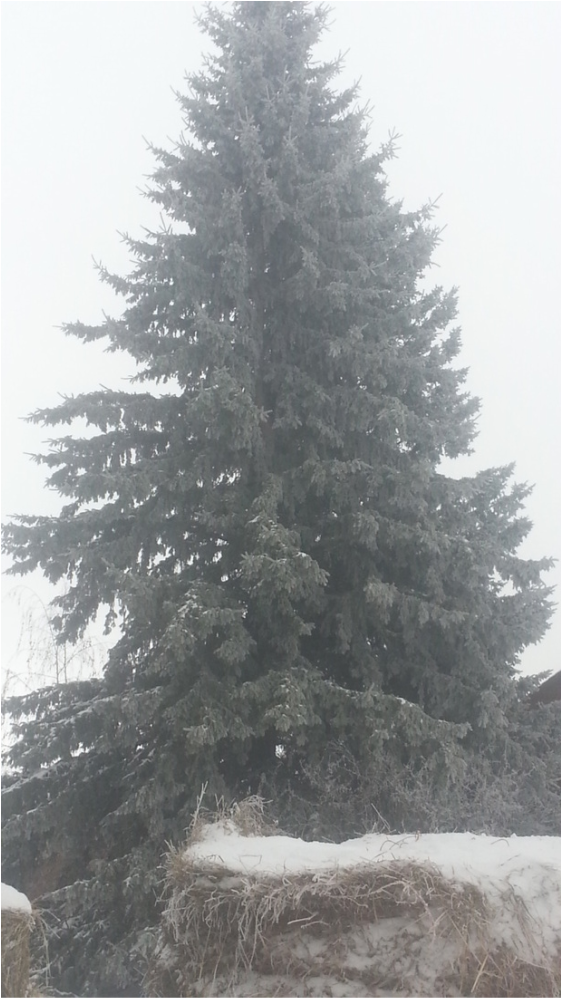 Yesterday was a busy and very disappointing day. The shearing did not go well and it was pouring rain, with the sheep being quite wet. That made it difficult to shear easily and there were many cuts. Then after the long afternoon and simply bagging the wool with the plan to spread it to dry in various places, I made dinner for the bed and breakfast guests - a wonderful couple from Edson, about 4 hours away, though still in Alberta. After cleaning up the dishes, I finally fell into bed at 11 and set the alarm for 7 am so I could make breakfast for the guests. Then the beds were changed, bathrooms and rooms cleaned, dishes done and laundry done. Once the guests departed, it was time to do the chores, feed the animals and put the other three ram lambs that were missed with the ram lambs that were sheared. Mamma sheep was also missed so she needs to be moved, though that is not easy. I drove to Bonnyville to pay for hay and thanked the Creator et al that I managed to get some, because I have only one bale left and that would only last a week with all the animals. For that I am grateful. Then I went to pick up some raw bones and scraps for the dogs from the butcher. They were butchering a beef so there were three boxes of good meat and bones for the hounds. When I got home I had to feed the animals again because they had small rations this morning and water them too. There were 7 more eggs to collect. The fleece never got sorted to dry, but there is the promise of tomorrow. Now, to a nice warm bath. Whew! 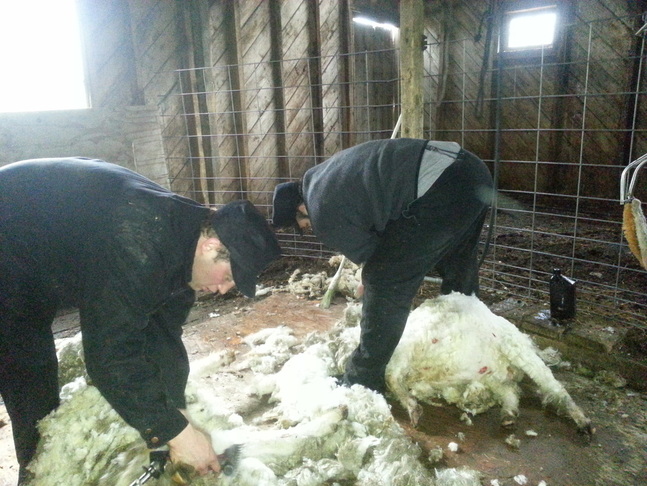 This was the fourth engagement to have the sheep sheared after having been put off three earlier dates. The shearers were late over an hour. Had they come earlier, it was not raining, but had started to drizzle when they arrived. They were not prepared, brought nothing other than their shears and depended on me to supply whatever they needed. They were not fast and the job was terrible with lots of huge gashes in the sheep and blood and second cuts on the wool . The sheep were wet and the wool will have to be laid out carefully to dry and turned regularly so ensure it is dry. Rain is predicted for the next 3 days, so drying will be slow. Then they asked for cash, because if they got a cheque, they would have no money to spend for booze. I am not happy, feel terrible for the sheep. Some not only have cuts, but have terrible bits that were not shorn and pieces hanging here and there. Plus three sheep were missed and they did not do the alpacas or the llamas. My poor sheep, I feel so sorry for them. 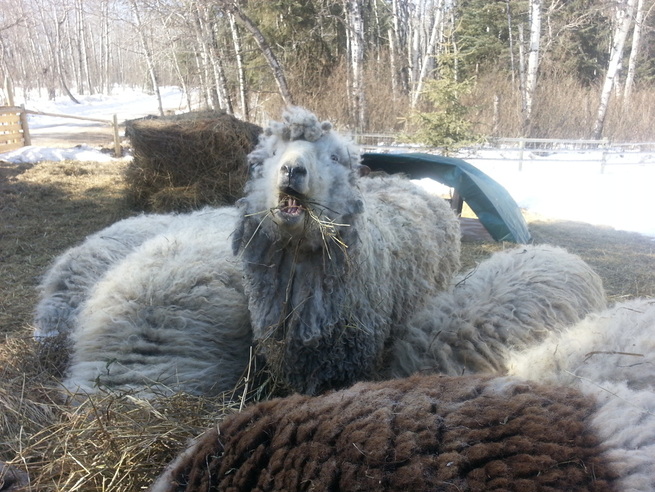 Hello, my name is Walter and I am on grass. I have been using grass for as long as I remember with no side effects and I highly (no pun intended) recommend it. Hello, my name is Walter and I am on grass. I have been using grass for as long as I remember with no side effects and I highly (no pun intended) recommend it. Tomorrow is try number three to have the sheep sheared. I still have fleece from last year in the garage. It is dry, but is raw, that is unwashed. Certainly it can still be used for whatever purpose, though, and hopefully, tomorrow, there will be a garage full of new fleece. The only problem is that the forecast is for rain and snow, yes, snow! It was 16 today and lovely and is not supposed to be cold tomorrow, but the air where the clouds are could be and that is where the snow could come from. The thing is, the shearers won't sheer wet sheep. And that is bad because they are very pregnant and due anytime now and need to be sheared so the lambs don't mistake a manure caked chunk of wool for a teat. Also, the wool gets weak at shearing so it will have a break in it which diminishes its quality. It would indeed be a sheepy deal if the shearers put me off yet again. These little wooly wonders really need their furry coats off. ...thinking positive good thoughts, I am.  Sheep have a bad rap for being dumb and impersonal, but if that is how they are treated, then what more can they be? I have dumb and impersonal sheep. The Dorset ewe was from a large commercial flock and all the handling was done in metal systems. The only contact the sheep had with humans was traumatic when they were jabbed with needles, or tipped upside down and had their hooves trimmed, or when their heads were twisted backwards to get them to lie down to be sheared. No wonder she runs when she sees me. I might be able to tame her over time, but I do not have the desire. It would take so much effort because she is totally untrusting and wild. She has taught her ram lamb to be the same way, because that is all she knew. When he is separated at the end of this month, for weaning, I will begin to try to work with him. If he is to be a breeding ram, he will need to be much calmer and even halter trained. His other fate is to be meat for the table. But sheep are not dumb or impersonal. I sold two sheep, a wether and a ewe lamb, to a family near by. These sheep were specifically chosen for their gentle trusting natures. The male wether, Morgan, was rejected at birth by his mother, who liked his sister and not him, so he was bottle fed. Morgan completely trusted humans then and loved me as he would have his mother. I spent time with him, stroked his back, rubbed his ears and spoke kindly. Louise followed Morgan's direction, though her nature was sweet and she was cautious, but not scared. In a short time, she was curious about the humans, since Morgan was absolutely comfortable, and soon she, too, became one of the family. They allowed the sheep in the house for very brief periods, and when they go out for a walk, the sheep come with them. In these recent photos, the family is enjoying the campfire and the sheep are just there as part of the family. The family has young children and a baby and all are thrilled to have sheep as pets. Wouldn't you love to have two wooly little companions too? 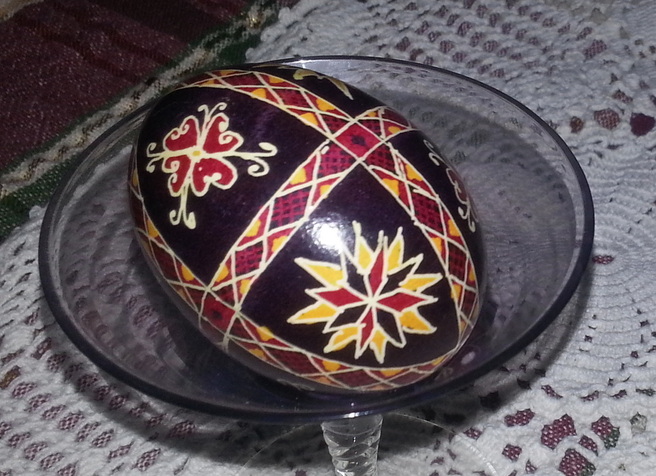 It is the evening of the day. I sit and my tender heart fills with many thoughts, thoughts of joy, gratitude, wonder, peace and hope. In the world of doom and climate change, visiting aliens, and threats of nuclear war, terrible disasters, radiation spills and oil leaks, dying animals and the extinction of species, one could see an end with no hope for humanity. Easter is a time of resurrection; the dark days are gone and the promise of a vibrant, green spring is at hand. Long before Christianity, the egg symbolized the rebirth and the decorating of the egg with pagan symbols can be dated to thousands of years before Christ. The colours of the egg all have meanings as does each intricately drawn and carefully executed picture. Thinking back to when the women sat by candlelight in cold homes, nimble fingers deftly drawing hope on simple gifts of eggs, I cannot help but be grateful for this life I have. My days are full of love, laughter and joy, play with my dogs, and evenings of platitude and warmth. In the far distance, a lone coyote cries, seeking a simple meal to fill his hollow belly and the loon calls his last voice to tenderly kiss the warmth of the sun goodnight. The big beautiful dogs, protectors of this paradise, work during the shadows, listening for sounds in the night that are amiss with the peacefulness of their existence. Some nights are quiet, the frogs signing in harmony with a chorus that lifts to the tall trees who dance gracefully to the tune, but the guardians do not slumber, for they would give their lives if called upon to do defend their world. That is their nature, their breeding of hundreds of years, natural guardians of the night and giant lovers during the light of the day. One can choose to worry about all things awry or one can choose to live in bliss, to rise above the ghetto or the misery and float on gossamer wings transcending the pettiness of terrible distraught upon the Earth. One can be caught in the web of the garish spider, both terrified to be bound and too traumatized to move, in case the reaction results in death, or one can revel in the lightness and freedom of the silk spun web and make friends with the hungry spider. And so, Easter, today, the day wrapped in Pagan historical celebration, I broke bread and drank rum with a good friend in the morning, the lovingly prepared basket feast blessed by the voice of his religion. While I partook in the simple bounty, I gave thanks to my friend for sharing his meal with me and for his presence in my humble home, to the animals whose lives were lost to provide the tasty meats and to the plants that died to feed my body. All is from the Creator and to the Creator, I am grateful for my life and blessed to be alive on this most glorious Easter day. There is much hope for a brilliant future. I feel it. |
Categories
All
AuthorFluffy writes daily about the experiences on the farm and with the bed and breakfast patrons. Archives
October 2020
|


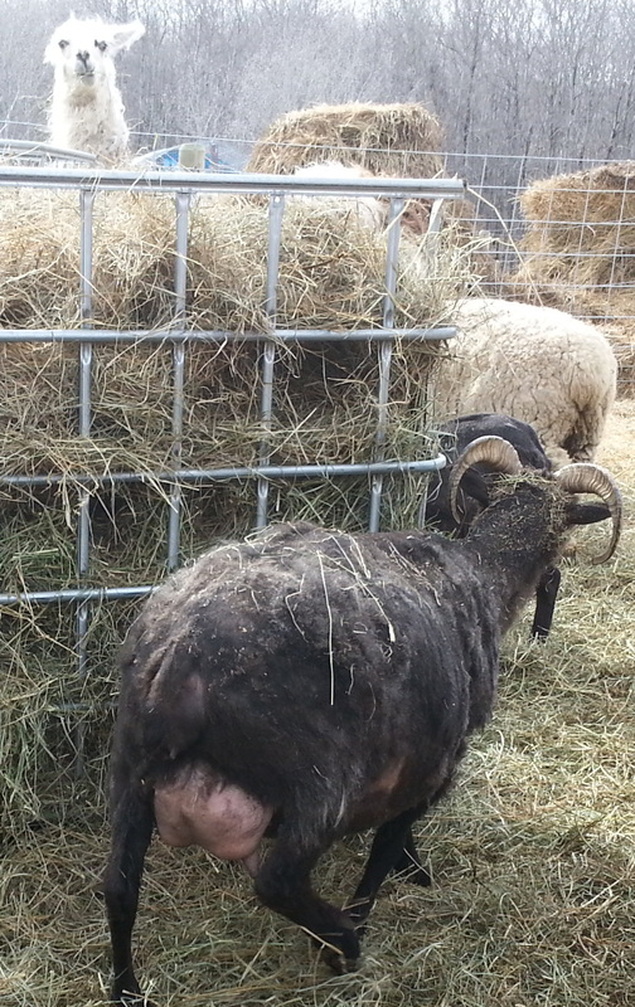
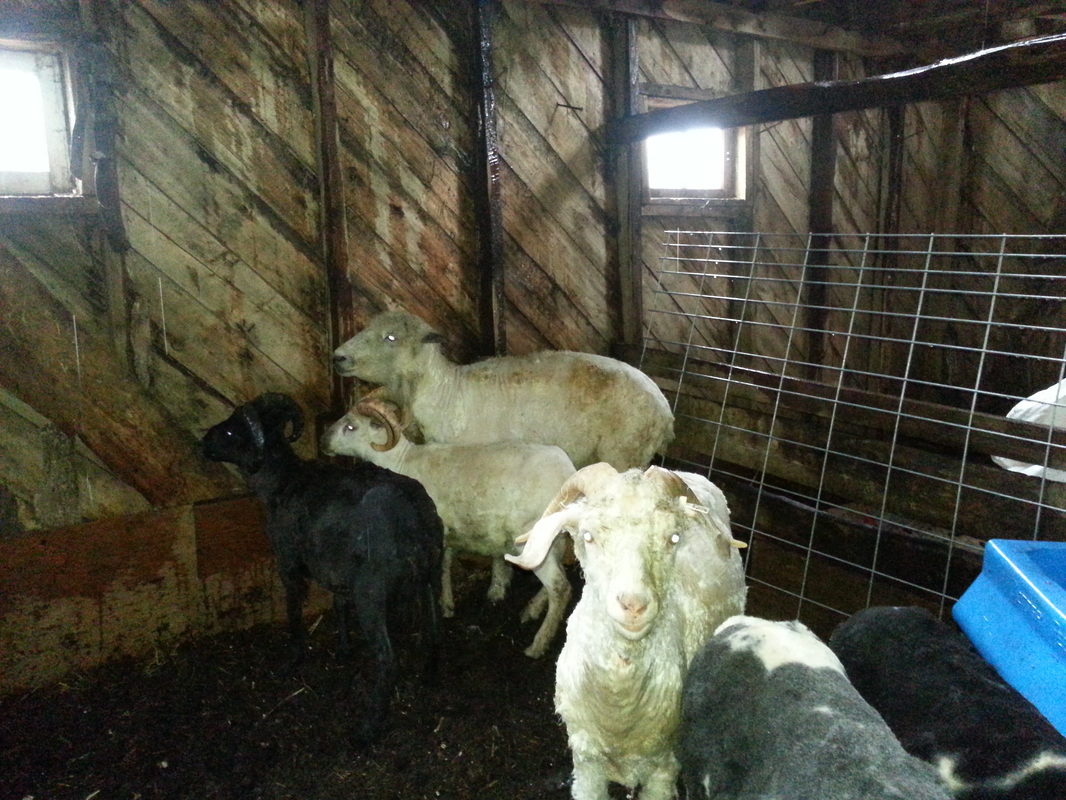
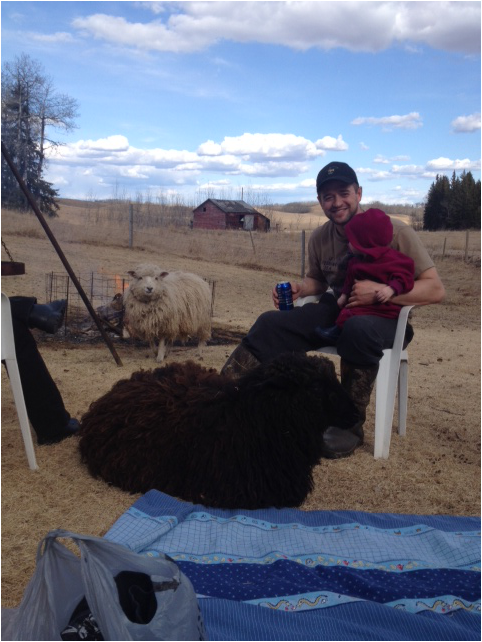
 RSS Feed
RSS Feed